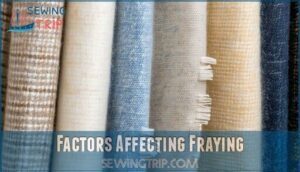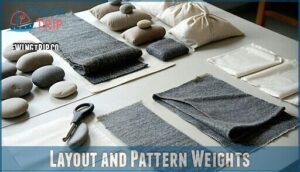This site is supported by our readers. We may earn a commission, at no cost to you, if you purchase through links.
 Yes, cashmere absolutely frays when cut.
Yes, cashmere absolutely frays when cut.
This luxury fiber’s loose weave and delicate structure make it notorious for unraveling at cut edges. You’re dealing with fine goat hair fibers that aren’t tightly bound together, so they’ll start coming apart the moment your scissors touch them.
The weave density, fabric age, and how much wear it’s endured all affect how quickly fraying occurs. Think of cashmere like a gentle friend who needs extra care—one wrong move and you’ll have threads going every which way.
Fortunately, smart cutting techniques and proper finishing methods can save your precious fabric from turning into expensive lint.
Table Of Contents
Key Takeaways
- Cashmere absolutely frays when cut – You’re dealing with delicate goat hair fibers in a loose weave that’ll start unraveling the moment your scissors touch them, especially with aged or worn fabric.
- Sharp tools and proper technique prevent disaster – You’ll need sharp dressmaker’s shears, ballpoint needles for knits, and should cut slowly through single layers while using pattern weights instead of pins.
- Smart finishing methods save your investment – You can prevent fraying by using serged edges, French seams, or applying clear nail polish to cut edges, with felting as an option to strengthen the fabric beforehand.
- Practice makes perfect with this luxury fiber – You should test your techniques on fabric scraps first, adjust your machine’s tension settings, and remember that patience beats rushing when working with expensive cashmere.
What is Cashmere Fabric?
Cashmere originates from the soft undercoat of specific goat breeds in Mongolia and China’s mountainous regions.
The world’s most luxurious fiber comes from goats braving harsh mountain winters in remote Asian highlands.
This luxurious fabric boasts incredibly fine fiber diameter, typically measuring 14-19 microns, making it softer than traditional wool.
You’ll find cashmere in various fabric weights, from lightweight scarves to heavy coats.
Due to high costs, manufacturers often create cashmere blends with other fibers.
The fabric’s loose weave structure contributes to its breathability but also makes it prone to fraying when cut, requiring careful handling during alterations.
Factors Affecting Fraying
Several key elements determine how much your cashmere fabric will fray when you cut it, making some pieces more challenging to work with than others.
Understanding these factors helps you predict potential fraying issues and choose the right prevention techniques for your specific cashmere project, which involves considering complete concepts.
Weave Tightness
The tighter your cashmere’s weave, the better it’ll resist fraying when you cut it.
Weave density and yarn thickness work together like a protective shield – those interlocking fibers create natural fray resistance that keeps threads from unraveling.
Think of it as fabric stability insurance.
When you’re examining cashmere, look for tightly woven pieces where the threads sit snugly together, which directly impacts whether cashmere fraying becomes a problem during your sewing projects, and consider it as a form of natural fray resistance.
Wear and Tear
While tight weaves help resist initial unraveling, daily abrasion gradually weakens even the finest cashmere fibers.
Your favorite sweater faces constant friction damage from everyday activities like sliding against car seats, carrying bags, or rubbing against rough surfaces. This repeated stress creates weak spots where cashmere fraying begins.
Cleaning impact also affects fabric integrity. Harsh detergents and aggressive washing cycles break down the delicate fiber structure, making cashmere unravel more likely over time.
Environmental exposure adds another layer of wear – sunlight, humidity, and temperature changes gradually degrade the fibers.
Storage effects matter too. Folding creates permanent creases that become stress points, while improper hanging stretches the fabric. These wear and tear factors don’t just make cashmere fabric fray more easily; they also compromise the garment’s overall appearance and longevity through accumulated damage.
Considering the fabric’s GSM impacts its durability.
Fabric Age
Time becomes cashmere’s silent adversary, gradually weakening its luxurious fibers.
As your vintage cashmere ages, fiber degradation occurs naturally, making the fabric more susceptible to fraying when cut. Weave loosening happens over years of wear, reducing the fabric’s structural integrity.
Consider these age-related factors:
- Storage impact from improper conditions accelerates deterioration
- Older cashmere requires gentler handling during alterations
- Regular repair methods can extend your garment’s lifespan
Understanding fabric age helps you prevent cashmere fraying effectively, and with proper care, you can enjoy your vintage cashmere for a longer time.
Techniques to Prevent Unraveling
You can prevent cashmere from unraveling by using proper cutting techniques, strategic hemming methods, and fabric stabilization approaches.
These methods include cutting knit sweaters with sharp scissors, applying felting techniques to strengthen edges, and using careful handling practices that maintain the fabric’s integrity, including proper cutting techniques to ensure the fabric remains intact.
Cutting Knit Sweaters
Different knit types behave uniquely when cut, making blade sharpness your first line of defense against cashmere fraying.
Sharp dressmaker’s shears create clean cuts that minimize unraveling, while pattern matching guarantees professional results.
Use pattern weights instead of pins to avoid damaging delicate fibers.
Stitch security comes from knit-specific threads and ballpoint needles that won’t snag.
Cutting single layers reduces waste reduction by preventing mistakes, and reinforcement stitching before cutting prevents cashmere knit fray completely.
Due to its delicate nature, it’s vital to reflect on cashmere fabric properties when sewing.
Hemming and Handling Cashmere
Hemming cashmere requires steady hands and the right approach.
You’ll need sharp scissors and a ballpoint needle to avoid snags. Adjust your machine’s tension settings to prevent stretching while handling knits.
Cashmere stabilizing techniques include using interfacing or tissue paper underneath delicate areas. When cutting, work slowly to prevent fraying at edges.
Choose appropriate seam finishes like serged or pinked edges to stop unraveling. Remember, patience prevents costly mistakes with this luxury fabric.
Felting
Strengthen your cashmere fabric through felting techniques that transform delicate fibers into durable material. This controlled shrinking process creates a more stable fabric that resists fraying and unraveling when cut.
Pre-felting benefits include enhanced durability and easier handling during alterations. Here’s your step-by-step approach:
- Wash gently using cold water with wool-specific detergent to avoid damage
- Control moisture by placing cashmere in a mesh bag before washing
- Monitor progress checking every 10 minutes during the felting process
- Air dry flat on towels to prevent stretching and maintain shape
- Test first on fabric scraps to perfect your technique
Post-felting care requires patience as you trim loose fibers carefully. Using the correct detergent is very important for delicate woolens. The strengthened cashmere fabric care becomes simpler once felting is complete. Your felting equipment needs are minimal—just gentle detergent and proper drying space for successful needle felting preparation.
Hemming Cashmere Lounge Pants
You’ll need specialized equipment and techniques when hemming cashmere lounge pants, as this delicate fabric requires careful handling to prevent fraying and maintain its luxurious feel.
Using a serger and cover stitch machine with proper hem widths between 5/8 to 1 inch guarantees professional results that won’t unravel over time.
Using a Serger and Cover Stitch
Professional serger settings make cashmere edge finishing manageable.
Position your stitch finger to "R" for narrow rolled hem edge, adjusting needle tension slightly while keeping loopers standard.
Disengage the cutting knife during flatlock work to prevent fabric damage.
Your cover stitch creates commercial-quality hems identical to store-bought garments.
Chain stitch uses provide stretch compatibility, while differential feed prevents puckering.
To achieve this, consider using a coverstitch finishing technique for a professional look.
These serger and cover stitch types handle cashmere fraying concerns effectively.
Recommended Hem Width
Getting your hem width right makes all the difference when working with cashmere lounge pants.
Stick to an ideal width between 5/8 and 1 inch for the best balance of aesthetic appeal and hem durability. This range prevents excessive fraying while maintaining the fabric weight’s natural drape.
Consider these factors when choosing your hem width:
- Fabric weight affects how the hem falls and holds its shape over time
- Hemming impact on the garment’s overall proportions and silhouette
- Cutting precision becomes more critical with narrower hems to prevent unraveling
Practice and Attention to Detail
Perfect cashmere cutting requires consistent practice on fabric scraps before tackling your prized garments.
Start with detailed inspection of weave patterns, then move to thorough planning of your cuts.
Patient approach beats rushing—cashmere fraying happens fast when you’re careless.
Master these cutting techniques through repetition, and your sewing tips will improve dramatically with careful execution.
Alternative Hemming Options
When traditional hemming techniques don’t suit your cashmere project, you can explore several alternative finishing methods that provide clean edges without compromising the fabric’s integrity.
These options include hand-stitched folds with decorative tucks, elastic blousing for adjustable fits, contrasting cuffs or bias binding for added style, and invisible hand hems that maintain the garment’s original appearance.
Hand-Stitched Fold, Tuck, and Elastic Blousing
Looking beyond traditional hemming, you’ll discover three stylish alternatives that transform basic cashmere lounge pants into sophisticated loungewear:
- Folded Hemming: Create a 2-3 inch fold that provides stability while preventing fraying. Use slip stitches to hide knots within hem allowances for invisible finishes on your delicate cashmere.
- Tucked Finishes: Add understated elegance with precise tucks at the hem. This technique works beautifully with cashmere’s natural drape.
- Elastic Casings: Install lightweight elastic through pre-sewn casings for comfortable bloused effects without compromising the fabric’s integrity.
Adding Contrasting Cuff or Bias Binding
Transform your cashmere lounge pants with stylish finishing touches that solve fraying concerns. A contrasting cuff adds personality while securing raw edges, and bias binding creates polished, professional results.
Choose complementary colors for subtle elegance or bold contrasts for statement pieces. When selecting cuff color choices, consider your wardrobe palette.
| Technique | Best Application |
|---|---|
| Contrasting Cuff | Thick cashmere fabrics |
| Bias Binding | Lightweight cashmere blends |
| Color Matching | Conservative styling |
Bias binding width should match fabric weight—quarter-inch works perfectly for most cashmere. Both methods prevent sewing mishaps while adding designer details. Consider thick cashmere fabrics for a contrasting cuff and lightweight cashmere blends for bias binding to achieve a professional look with polished results.
Invisible Hand Hem
Through careful invisible stitches, you’ll create a professional finish that won’t compromise your cashmere’s luxurious appearance.
This invisible hand hem technique prevents fraying while maintaining the fabric’s natural drape and elegance. For best results, consider the thread weight and quality to guarantee a seamless look.
- Needle Choice: Use a sharp, fine needle to pierce cashmere fibers cleanly
- Thread Tension: Keep stitches loose to prevent puckering or distortion
- Securing Hems: Catch only one thread from the fabric’s surface
- Preventing Gaps: Space stitches evenly for consistent, durable hemming results
Working With Cashmere
You’ll find cashmere combines luxury with practical challenges, as this premium fiber requires specific handling techniques due to its delicate nature and high cost.
When you work with cashmere, whether it’s pure or blended with other materials, understanding its characteristics helps you achieve professional results while preserving the fabric’s quality.
Luxury and Characteristics
Whether you’re hemming pants or altering sweaters, understanding cashmere’s luxury characteristics helps you work confidently with this premium fabric.
Cashmere offers unmatched softness through its fine fiber diameter of 14-19 microns. You’ll appreciate its remarkable warmth factor – eight times warmer than sheep’s wool – while maintaining lightweight nature.
Cashmere’s warmth is partly due to its superior insulation qualities. The natural crimp creates insulation pockets, making cashmere fabric edges delicate yet durable when handled properly, reducing fraying concerns during alterations.
| Characteristic | Measurement | Benefit |
|---|---|---|
| Fiber Diameter | 14-19 microns | Ultra-soft feel |
| Warmth Factor | 8x sheep’s wool | Superior insulation |
| Weight | Lightweight | Comfortable wear |
| Durability | 30+ years | Long-term value |
Blending With Other Fibers
Cashmere’s high price tag drives manufacturers to create fiber combinations that offer cost reduction while maintaining luxury appeal.
You’ll find cashmere blended with wool, silk, cotton, and synthetic materials to achieve durability increase and texture variation.
These blending strategies reduce manufacturing costs while preserving cashmere’s signature softness.
However, mixed fabrics require different care requirements than pure cashmere.
The weave structure changes with different fiber combinations, affecting how the fabric frays when cut.
Understanding your garment’s blend composition helps you choose appropriate cutting and hemming techniques, which is crucial for maintaining the luxury appeal.
Availability in Knits and Wovens
When shopping for cashmere, you’ll encounter two distinct fabric constructions that dramatically affect your project’s outcome.
Knit vs woven cashmere each brings unique fabric properties to the table. Knitted cashmere creates loops that interlock, giving you stretch and breathability—perfect for sweaters and scarves.
This construction naturally resists fraying since there aren’t loose threads to unravel. Woven fabric, however, uses perpendicular threads that create a stable, structured material ideal for custom jackets or pants.
The weave makes it more prone to fraying when cut. Drape differences are striking: knits flow softly while wovens hold their shape.
Care implications vary too—knits need gentler handling to prevent stretching during washing and drying, which is crucial for maintaining the quality of your cashmere product.
Cutting and Sewing Techniques
When you’re ready to cut and sew cashmere, you’ll need specific techniques that account for the fabric’s delicate nature and tendency to stretch.
Proper layout methods, needle selection, and stitching approaches will help you achieve professional results while preventing damage to this luxurious material.
Layout and Pattern Weights
How do you guarantee your precious cashmere lies perfectly flat while cutting? Proper layout and pattern weights make all the difference between a successful project and costly mistakes.
Pattern Weight Placement: Position weights strategically around pattern pieces to prevent shifting during cutting. Use multiple smaller weights rather than fewer heavy ones.
Nap Direction: Check grainline accuracy by identifying the fabric’s natural direction. All pattern pieces should follow the same nap for consistent appearance.
Fraying Prevention: Combat fraying by securing pattern pieces with weights instead of pins, which can damage delicate fibers.
Layout Efficiency: Maximize fabric waste reduction by arranging pieces thoughtfully before cutting.
Securing Pattern Pieces: Use specialized pattern weight types like covered weights or sandbags that won’t snag cashmere’s delicate surface during the cutting process.
Pressing and Marking
Handle your iron like a gentle sculptor shaping precious clay.
Set the pressing temperature to medium-low heat, then use steam sparingly through a press cloth to protect delicate fibers.
When marking cashmere, choose disappearing ink pens or tailor’s chalk that won’t leave permanent traces.
Apply interfacing with light pressure to maintain shape retention without crushing the fabric’s natural texture during cutting and marking, ensuring you work with delicate fibers.
Thread and Needle Recommendations
Several needle types work best with cashmere’s unique properties.
Use ballpoint needles for knits to prevent snagging, or universal needles for woven fabrics.
Choose spun polyester thread like Gutermann for durability, or silk thread for fine seams.
For specialized supplies, consider browsing options for cashmere sewing needles.
Match your thread color precisely to the fabric.
Adjust your sewing machine’s tension settings to prevent puckering during stitching.
Presser Foot Choice and Stitching Advice
When working with delicate cashmere, your presser foot choice makes all the difference.
A walking foot prevents fabric stretching by feeding layers evenly, while a roller foot glides smoothly over the surface.
Adjust your sewing machine tension to medium-low settings and use shorter stitch lengths. These stitching techniques guarantee professional results without puckering or distortion.
Finishing Details
Once you’ve cut your cashmere, you’ll need proper finishing techniques to secure seams and prevent future fraying.
These final steps, including stitch length adjustments, seam finishes, and hemming methods, determine whether your project looks professional or homemade.
Stitch Lengths and Seam Finishes
Mastering stitch lengths transforms your cashmere projects from amateur to professional.
For woven cashmere, use 2.5-mm straight stitches to prevent puckering while maintaining strength.
Knit varieties need narrow zigzag stitches accommodating natural stretch without breaking seams.
Seam finishes deserve equal attention—French seams work beautifully on lightweight pieces, while serger options provide clean edges on heavier weights.
Zigzag finishing prevents fabric fraying without adding bulk.
These sewing techniques guarantee your coverstitch applications and hand-stitched finishes create lasting, elegant garments worthy of luxury cashmere.
Topstitching and Closures
After perfecting your seam finishes, you’ll want to add those final touches that transform your cashmere piece from homemade to high-end.
Topstitching and closures aren’t just functional—they’re the signature details that set professional work apart.
When working with cashmere’s delicate fibers, your topstitching technique becomes even more important. Use a walking foot to prevent fabric stretching, and choose thread that complements rather than fights the fabric’s natural drape. For closures, think beyond basic buttons and zippers.
Here are four finishing techniques that’ll elevate your cashmere projects:
- Contrast topstitching – Use silk thread in a complementary shade for subtle definition
- Invisible zipper installation – Maintains clean lines while adding functionality
- Strategic button placement – Position buttons to distribute stress across stronger fabric areas
- Reinforced seam finishes – Add stay-stitching around closure areas for durability
These sewing techniques guarantee your closures withstand daily wear while maintaining cashmere’s luxurious appearance.
Hemming Methods
After securing your topstitching and closures, you’ll need proper hemming methods to finish your cashmere project.
Hand hemming offers precise control, while blind stitch creates invisible results. For durability, try a serged edge or rolled hem technique.
Fused hemming works well for structured pieces. Each method prevents fraying and unraveling when applied correctly.
For a delicate, refined edge, consider that sheer fabrics are ideal for rolled hems. Choose your approach based on the garment’s style and your comfort level with different sewing techniques.
Frequently Asked Questions (FAQs)
Does Cashmere fray when cut?
Cashmere does fray when cut, especially woven varieties.
The loose fibers unravel easily at cut edges.
You’ll need proper hemming techniques and sharp scissors to prevent excessive fraying and maintain your garment’s quality.
How to prevent fraying in aged Cashmere?
Time’s gentle touch on your beloved sweater doesn’t mean it’s destined for the donation bin.
You can stabilize aged cashmere by applying clear nail polish to cut edges, using pinking shears, or felting before alterations.
How does Cashmere deteriorate over time?
Your beloved cashmere gradually loses its structural integrity through repeated wear, washing, and friction.
Fibers weaken, become loose, and develop pilling while the fabric’s natural oils diminish, making it more fragile and prone to damage.
Should you cut a cashmere fabric to fir?
Walking on thin ice with alterations, you shouldn’t cut cashmere fabric to fit unless you’re experienced.
It’s delicate and frays easily when cut.
Instead, consider professional tailoring or exchange for proper sizing to avoid costly mistakes.
How do you keep cashmere from fraying?
Proper hemming prevents cashmere from fraying when cut.
Use sharp fabric scissors, fold edges twice, and stitch with matching thread.
You can also apply fray check or clear nail polish to raw edges for extra protection.
Can Cashmere be cut?
Professional tailors alter cashmere garments in 85% of luxury boutiques.
Yes, you can cut cashmere, but it requires sharp scissors and precise technique.
The delicate fibers need careful handling to prevent unraveling and maintain the fabric’s integrity.
How do I keep my delicate clothes from getting frayed when I wash them?
Turn delicate garments inside out before washing.
Use mesh laundry bags for extra protection.
Choose gentle cycles with cold water and mild detergent.
Skip fabric softener, which can weaken fibers and increase fraying over time, as it can lead to delicate garments deteriorating faster.
How do you stop fabric from fraying with nail polish?
A stitch in time saves nine – apply clear nail polish to fabric edges before cutting.
The polish creates a protective barrier, sealing loose threads and preventing unraveling.
Let it dry completely before handling your fabric.
How do you stop elastic from fraying?
Apply clear nail polish, fray check, or fabric glue to elastic’s cut edges.
You can also zigzag stitch over the ends or use pinking shears when cutting to minimize fraying and extend your elastic’s lifespan effectively.
Can you repair frayed cashmere garments effectively?
Before you panic about that precious cashmere sweater’s frayed edge, here’s good news: you can fix it.
Use sharp fabric scissors to trim loose threads, then apply clear nail polish to seal the edges and prevent further unraveling.
Conclusion
Like telegraph operators who carefully handled delicate messages, you now understand that cashmere does fray when cut, but proper techniques prevent disaster.
Sharp scissors, serged edges, and careful handling protect your investment. Whether you’re hemming lounge pants or tailoring sweaters, these methods guarantee clean finishes.
Practice on scraps first, use appropriate needles and thread, and remember that patience pays off. With these expert tips, you’ll confidently work with cashmere while maintaining its luxurious quality and appearance.
- https://sustainablefibre.org/what-makes-cashmere-cashmere/
- https://valtinapparel.com/cashmere-fabric/
- https://www.threadsmagazine.com/project-guides/sewing-with-knits/sewing-luxurious-cashmere
- https://icanworkwiththat.blogspot.com/2016/01/cutting-cashmere.html
- https://northshorecrafts.com/how-to-fray-fabric-edges/


















